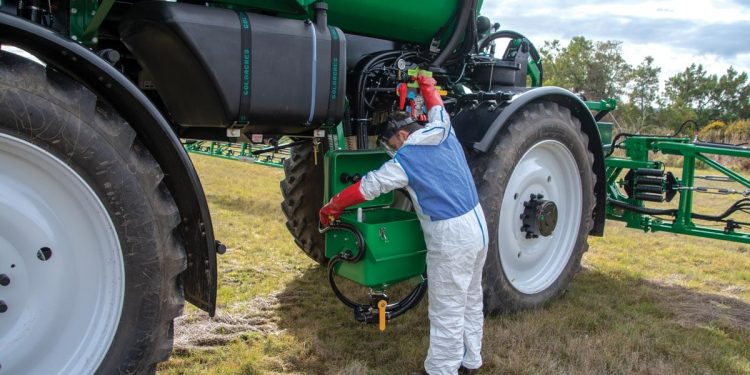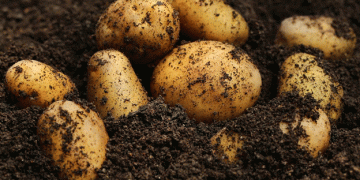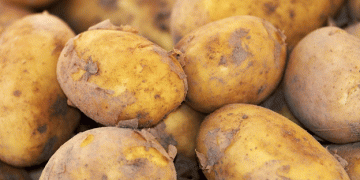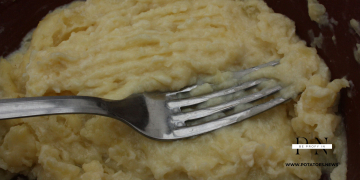A new report indicates the pyrethroid sensitivity of two important aphid virus vectors. Sue Cowgill, AHDB Crop Protection Senior Scientist (Pests), looks at what the results mean for potato growers.
- Aphid monitoring home
- Pyrethroid sensitivity in UK cereal aphids
- Insecticide Resistance Action Group (IRAG)
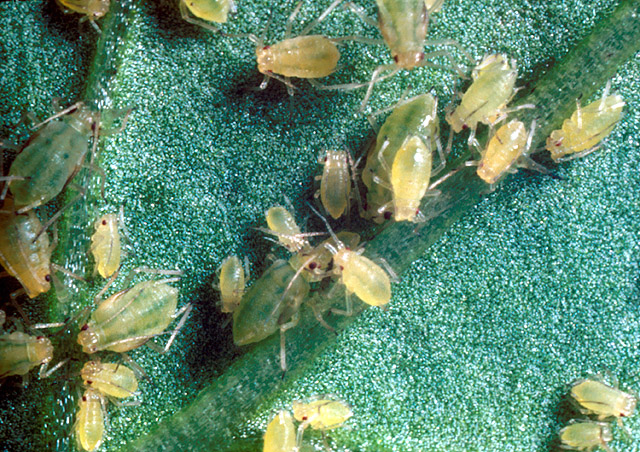
These days, growers have access to fewer modes of action to control insect pests. Concerns that this encourages the emergence of resistance are recognised in the Draft National Action Plan for the sustainable use of pesticides. While this may eventually deliver a comprehensive strategy for insecticide resistance management; in the short term, we have to use the information and insecticides that are available now.
Viral variation
When it comes to management, it is important to be clear about which viruses are being considered. They vary in how quickly they are picked up and passed on by aphids. In turn, this influences how effective insecticides will be, and the target aphids. In potatoes, the commercially important viruses fall into two main groups.
1. Potato leaf roll virus (PLRV)
In the UK, Potato leaf roll virus (PLRV) is mainly spread by the peach–potato aphid, but other colonising aphids, such as potato aphid, can be involved.Aphids feed and pick up PLRV, but it takes hours before they are able to pass it on. However, infected aphids can continue to spread virus for their entire lives (it is a ‘persistent’ virus).Because of the time lag, it is reasonable to expect insecticides to help break the transmission cycle. Consequently, resistance status is critical for PLRV management.

2. Non-persistent potyviruses
The non-persistent potyviruses, such as Potato Virus Y (PVY), are the most problematic in GB potato production. When aphids probe leaves, virus particles are picked up on the tips of their mouthparts. These can be passed on within minutes, if not seconds. Even when potatoes are not the traditional host for the aphid, they can still become infected via random aphid probing.
The speed of transmission means that insecticides often struggle to break the cycle. In addition to increased reliance on non-chemical control, more aphid species need to be considered for these viruses.The peach–potato aphid, grain aphid, bird cherry–oat aphid and willow–carrot aphid are the key species associated with PVY in seed potatoes in Scotland, according to researchers.
Insecticide resistance status
Peach–potato aphid
Because of its key role in PLRV and PVY spread, it is essential to know the insecticide resistance status of this aphid. Unfortunately, it has proved adept at developing resistance – about 80% of English samples show resistance to pyrethroids – with two forms present:
- Super-kdr (most common) confers high levels of resistance to pyrethroids.
- kdr confers moderate levels of resistance (present in about 45% of samples).
As super kdr predominates, a non-pyrethroid should be used for peach–potato aphid control. Instances of neonicotinoid resistance have been reported in peach–potato aphids overseas. A limited number of field-collected samples are screened in GB each year to monitor for reduced sensitivity to acetamiprid, as well as flonicamid and spirotetramat. So far, there is no evidence of reduced sensitivity to these actives.
Grain aphid
The first concerns about pyrethroid resistance in grain aphids date back to 2011. The presence of the kdr mutation was confirmed and shown to require about 40 times as much active to kill the resistant forms, compared with the fully susceptible grain aphids. A technique was developed to screen aphids (from the national suction trap network) for the kdr mutation. In 2019, samples were tested from five traps, and up to 30% of the aphids had the mutation.
However, this type of testing does not provide information on other forms of resistance. As a result, in 2020 a small number (5) of live grain aphid samples were also collected from cereal fields and tested in lab bioassays. This showed no increase in the strength of resistance since 2011 and that there is still probably only kdr resistance in grain aphids. In practical terms, pyrethroid sprays applied at the full recommended rate should control grain aphids. However, their effect on PVY transmission is more likely to be influenced by the timing and frequency of grain aphid flights, than the resistance status of the aphids.
Bird cherry–oat aphid
Despite reports of reduced sensitivity to pyrethroids in a sample of bird cherry–oat aphid from Ireland, bioassays on GB samples (21) from 2020 show no evidence of the problem being present here. Currently, pyrethroids should provide control of bird–cherry oat aphid. That’s good news for cereal growers concerned about BYDV, which is a persistent virus and more amenable to control through the use of insecticides than PVY.
Willow–carrot aphid
The picture for willow–carrot aphid is less clear. In particular, researchers do not have historical data on the sensitivity of the pest to pyrethoids. Without data for a fully sensitive form of the aphid, it is not possible to calculate a resistance factor (as has been done for the cereal aphids). An alternative approach is to test the aphids using an equivalent of the field rate. So far, only six samples have been tested this way and the kill ranged from 30% to 70%. More samples are needed to get a better national picture for this pest.
Aphid monitoring resources
The AHDB yellow water trap network provides local information on flights across GB. The results from 2020 highlight the variability in aphid numbers and species. At-a-glance information, including resistance status and spray programme information, is available on our aphid and virus pages.
Ultimately, the industry needs to turn to integrated approaches. This includes long-standing measures, such as the management of virus inoculum sources. However, it also means the adoption of other alternatives – such as use of intercropping, mulching and mineral oils. These are being investigated in our SPot farm network and, hopefully, trials and results will be available to view in 2021 (subject to the progress with the control of a totally different virus).
